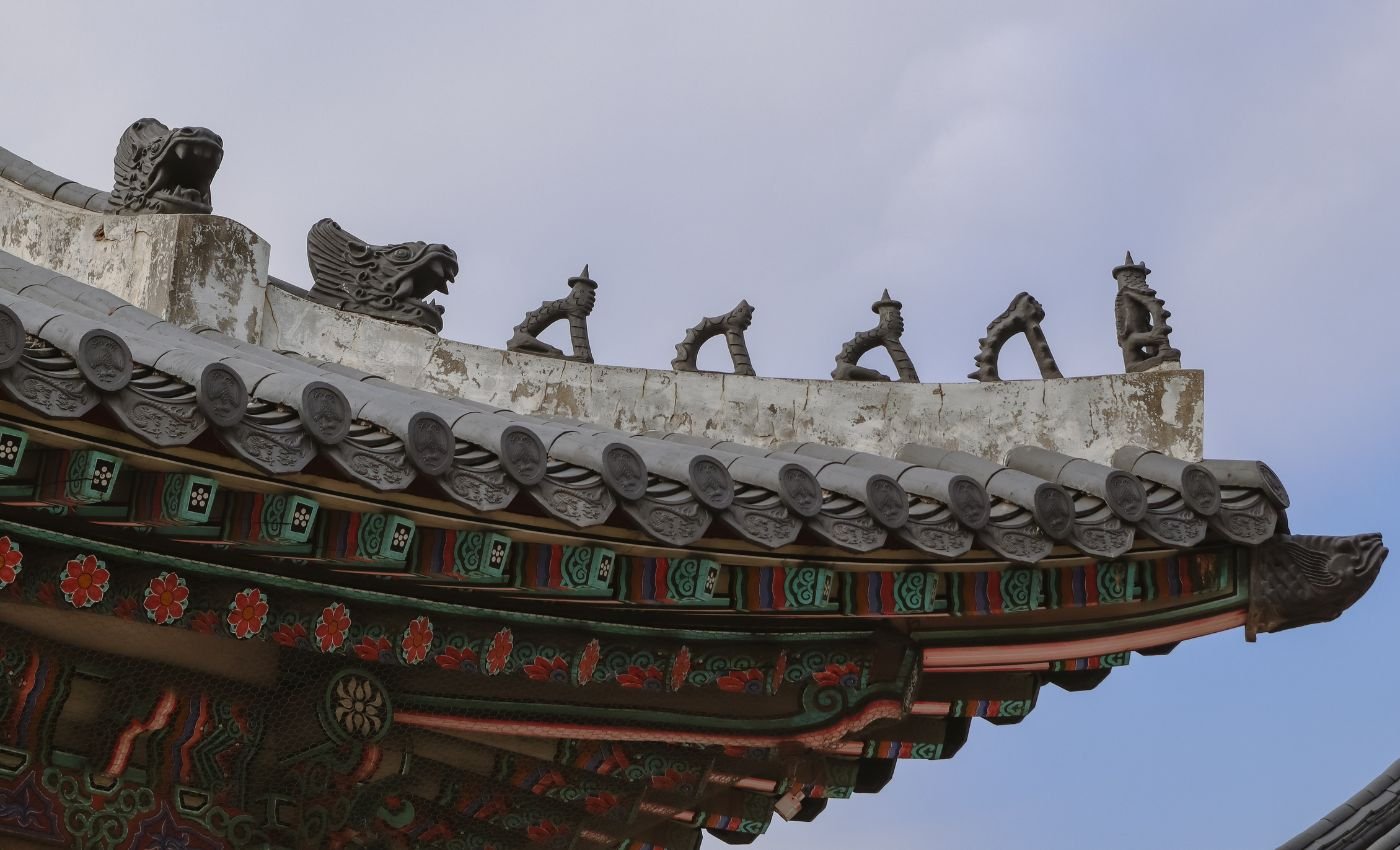
3-Day Korea Itinerary for Winter: A Complete Traveller’s Guide
Korea was initially just a stop-over destination for me—a convenient, cheap flight connection on my way to the Philippines. However, it quickly turned into one of the most memorable and enriching cultural trips I’ve ever experienced. With a short timeframe, I did extensive research to maximise every moment, and I’m delighted with all the experiences I managed to pack into my schedule. This Korea itinerary will give you a glimpse of the must-see highlights in Korea over the winter season.
I’ve crafted this itinerary to focus on three full days in January, which is winter in the southern hemisphere. Based in Seoul, this itinerary can also be completed over four days at a more leisurely pace.
In this guide, you’ll learn how to dive deep into Korea’s rich heritage by exploring ancient palaces, enjoying cosy tea houses, sampling iconic Korean dishes, and even venturing to the DMZ. Alongside these cultural experiences, I’ve included practical tips on where to stay, how to get around, what to bring, and what to expect when travelling in Korea during winter.
If you’re keen on sipping soju, escaping the cold in a snug tea house, indulging in sizzling Korean BBQ, or simply immersing yourself in the local culture, this Korea itinerary has you covered!
This post contains affiliate links. If you make a purchase through these, I may earn a small commission at no extra cost to you, which helps me keep this blog running. Thanks for your support 🙂
Table of Contents
ToggleWinter in Korea
If you’re considering a winter trip to Korea, January offers a unique opportunity to experience the country in a whole new light. With cheaper flights and accommodation thanks to the low season, it’s a great time for budget-conscious travelers. Plus, with fewer tourists around, you can enjoy a more immersive experience of Korea’s rich culture and history.
One of the highlights of visiting Korea in winter is the chance to participate in winter festivals exclusive to the season, like the Hwacheon Winter Festival. The snow-covered landscapes are also a breathtaking sight, especially if you venture into the mountains or countryside.
On the flip side, the main downside is the cold. Temperatures can plunge as low as -10°C (14°F), and even lower in the mountains and rural areas. While it can be a bit challenging if you’re not used to the chill, with the right winter gear (thermal layers and gloves are essential!), you’ll be ready to embrace the season and make the most of your trip.
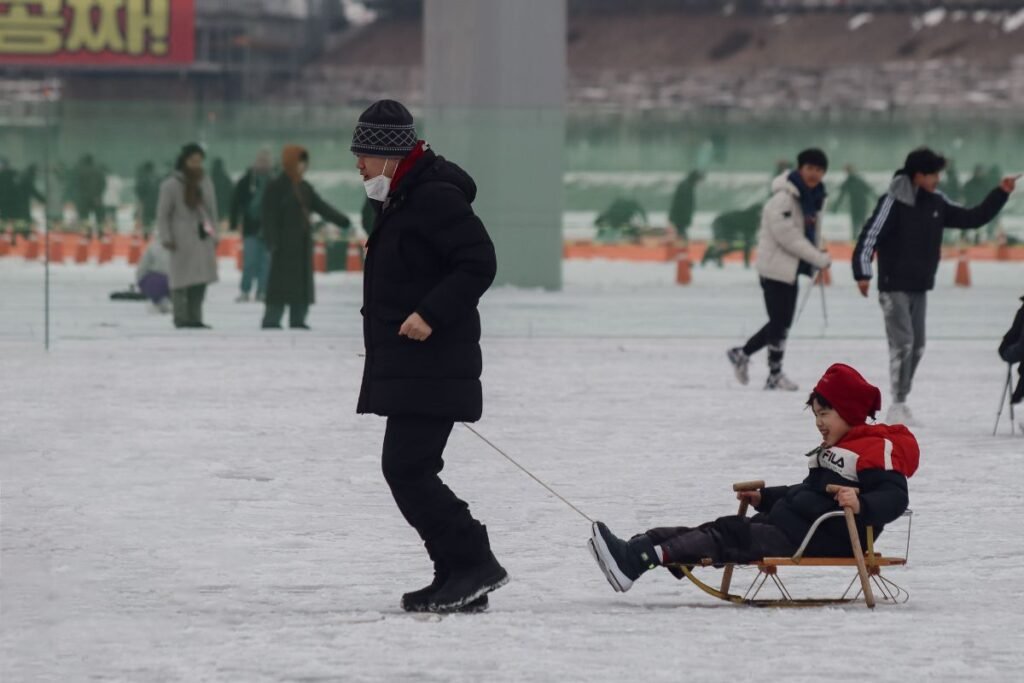
Where to Stay in Seoul
For first-time visitors or those on a tight schedule, Myeong-dong is the perfect base. This vibrant hub is conveniently located near major attractions, including the bustling Myeong-dong Night Market, famous for its endless street food and shopping options. Well-connected by subway lines, it offers easy access to explore the city. Plus, you’ll find a wide range of accommodation options, from budget-friendly stays to luxury hotels, and plenty of restaurants to satisfy your cravings. Additionally, many tours (such as those to the DMZ) pick up and drop off at Myeong-dong Subway Station, which is particularly convenient for early morning departures.
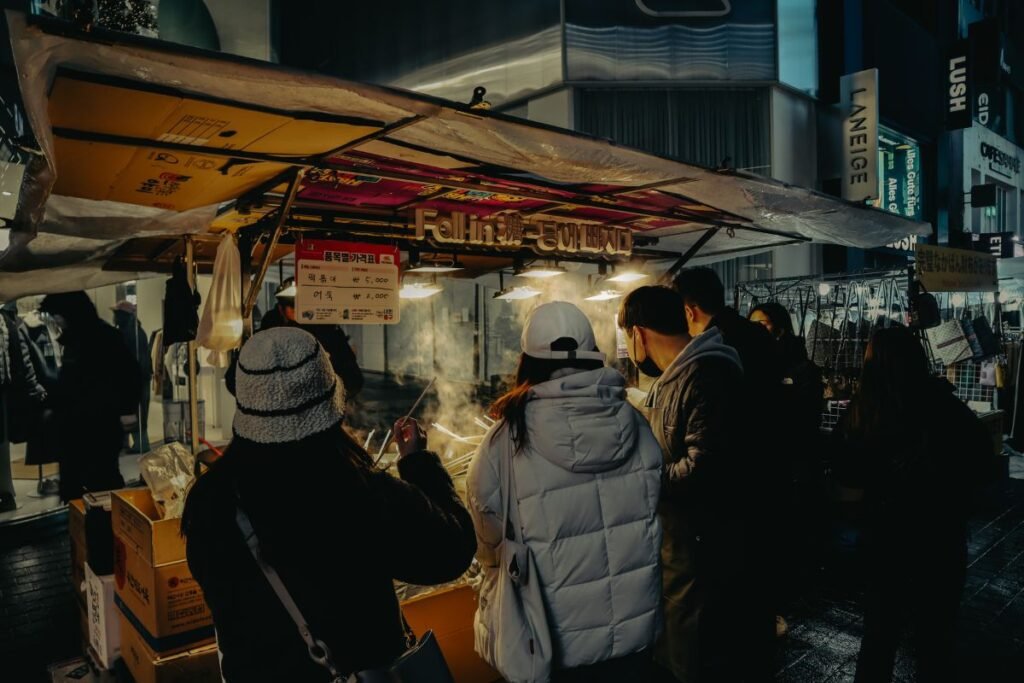
Public transport in Korea
- Seoul has an extensive and efficient public transport system, ranked among the best globally for ease, cleanliness, and service frequency.
- The subway is one of the most efficient ways to travel around, with colour-coded lines and signs in Korean, English, and Chinese.
- Google Maps doesn’t work well for transit; download NAVER instead.
- Subway rides can be paid with cash single-ride tickets at vending machines or a T-Money card from convenience stores. More info here.
- International Taxis have drivers fluent in English, Chinese, or Japanese, with the language displayed on the vehicle.
- Taxis from the airport to downtown cost around 85,000 won (~$58 USD), and can be booked in advance here.
- For groups of 4+, consider booking an extra-large vehicle through Viator for a cheaper option.
- The Airport Railroad Express (AREX) takes 45 minutes to downtown and costs 13,000 won (~$9 USD).

Korea Itinerary
Day 1 - Seoul
Transport tip: The following list of places can be accessed by subway. Get off at Gyeongbokgung or Anguk station (line 3 orange).
Gyeongbokgung Palace
Gyeongbokgung Palace is a must-see on any South Korea itinerary. As the largest and arguably most beautiful of Seoul’s Five Grand Palaces, it offers a captivating peek into Korea’s Joseon dynasty, blending impressive architecture, a rich cultural history, and beautifully landscaped gardens.
Built in 1395, Gyeongbokgung was the official residence of the Joseon kings. Though it was destroyed during the Imjin War (1592–1598) and abandoned for two centuries, it was restored in the 19th century under King Gojong. Unfortunately, much of the palace was later destroyed by Imperial Japan during its occupation of Korea. Since the 1990s, restoration efforts have been underway to bring the Korean palace back to its former glory.
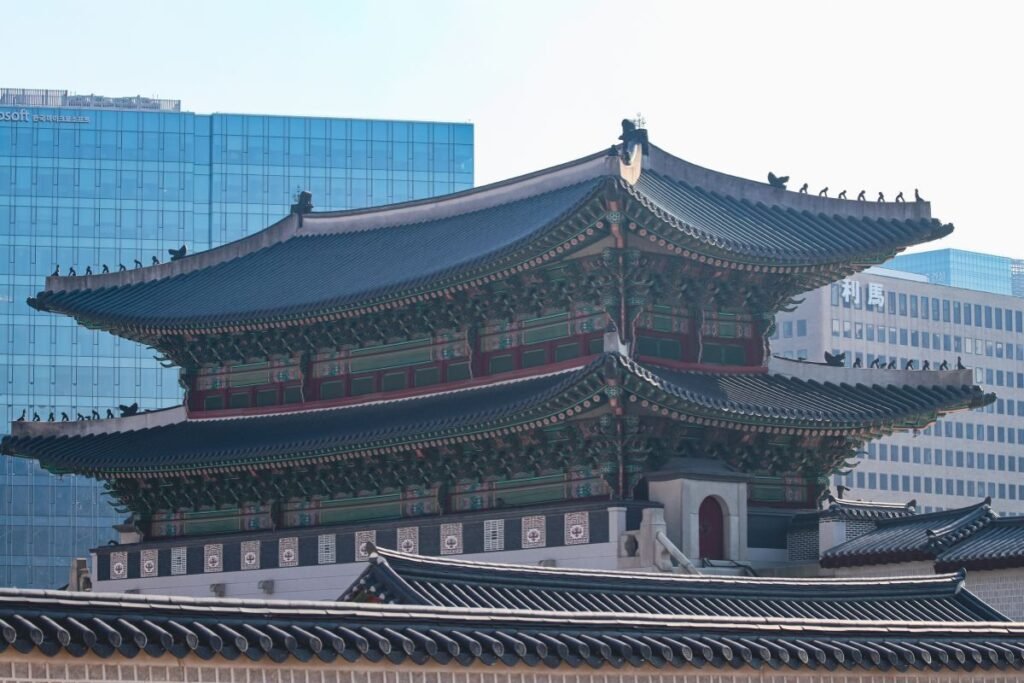
The entry fee includes guided tours in several languages every day. I joined one in English that provided a fascinating insight into the palace’s history and numerous important spots.
I visited in winter, and while it was chilly, the brisk air and plenty of walking kept me warm. The palace grounds offer fantastic photo opportunities, from elegant pavilions to ornate gates and serene reflections in the ponds.
If you’re keen to immerse yourself in Korean culture, consider renting a hanbok (traditional Korean clothing), which grants free admission. For everyone else, the entry fee is 3,000 won (about $2 USD).
Opening hours:
November – February (Winter): 09:00 – 17:00
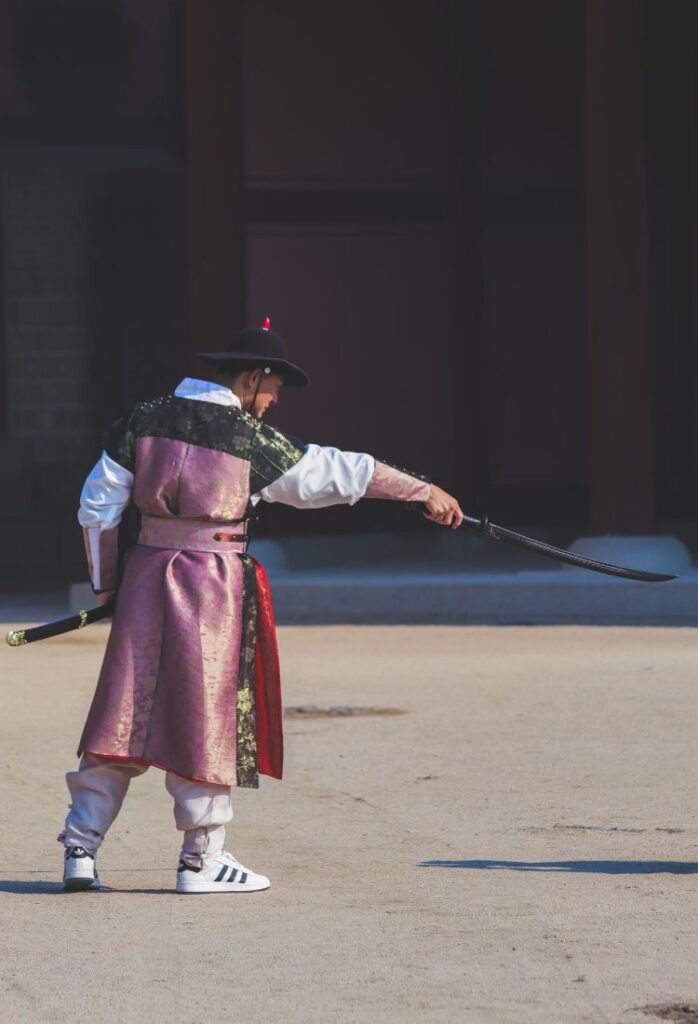
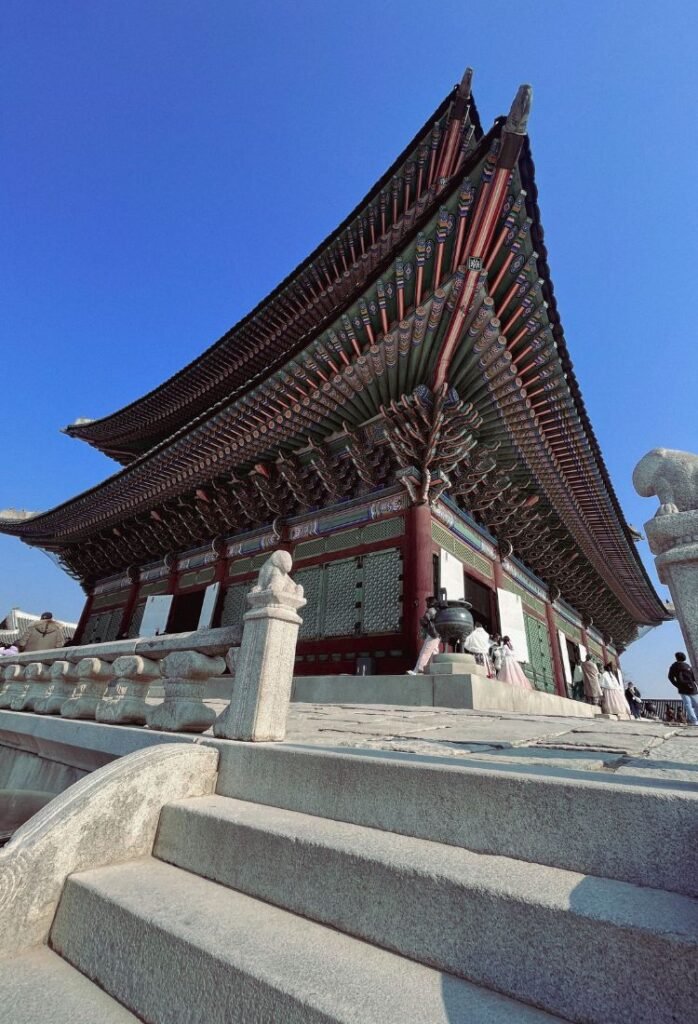
Left: A tourist wearing a hanbok poses for a photo. Right: Geunjeongjeon, the main hall of Gyeongbokgung Palace.
National Folk Museum of Korea
Located within Gyeongbokgung Palace grounds, the National Folk Museum of Korea is a perfect next stop to explore Korea’s everyday traditions and cultural heritage. The museum features engaging exhibits on Korean life during the Joseon dynasty and beyond, with artefacts, costumes, and interactive displays that bring history to life. Its proximity to the palace makes it a convenient addition to your itinerary, offering deeper insights into the context of your visit.
Admission: free of charge.
Opening hours: Every day, 09:00-17:00.
Bukchon Hanok Village
Bukchon Hanok Village is a charming maze of traditional Korean houses (hanoks) nestled between Gyeongbokgung and Changdeokgung Palaces, making it an ideal stop after exploring these historic sites. Walking through its narrow streets feels like stepping back in time, offering a glimpse into Korea’s architectural heritage and traditional living. As a residential area, visitors can only visit during its official hours.
I loved wandering the streets of Bukchon Hanok Village in winter, with the crisp air adding a special atmosphere to the village’s unique rooftops and wooden facades. The area is a haven for photographers, with endless opportunities to capture picturesque hanoks against the backdrop of modern Seoul.
Admission: free of charge.
Opening hours: Weekdays & Saturdays 10:00-17:00.

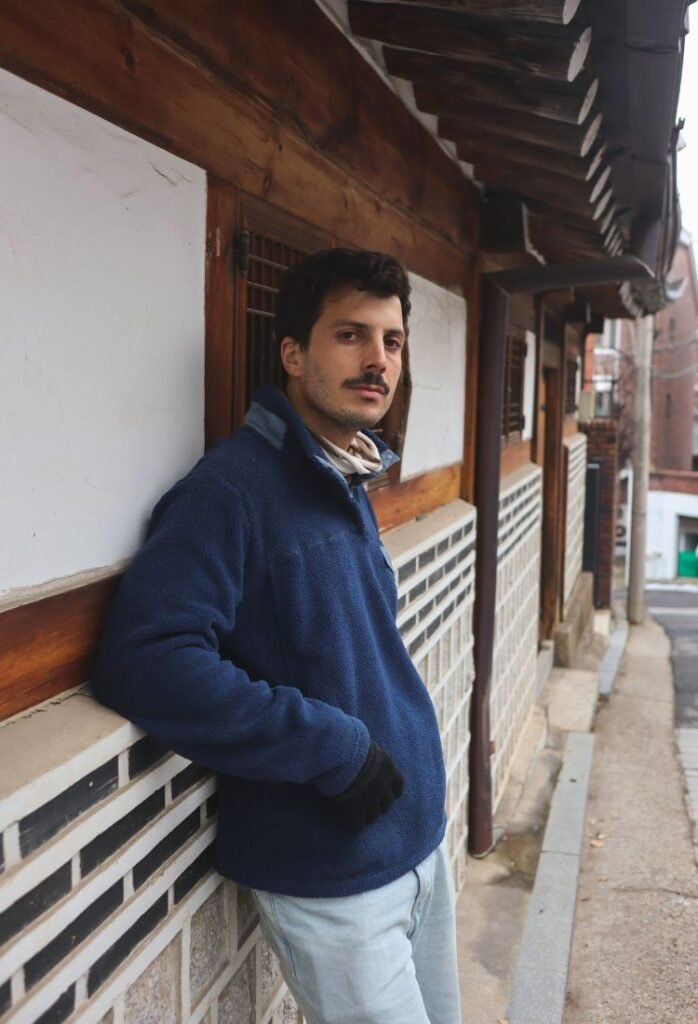
Bukchon Hanok Village is home to hundreds of traditional houses that date back to the Joseon dynasty.
National Museum of Korean Contemporary History
The National Museum of Korean Contemporary History focuses on Korea’s modern journey, covering key events from the late 19th century to today, including colonisation, the Korean War, and rapid economic development. It contrasts with the National Folk Museum, which highlights traditional Korean life and culture. This museum offers engaging exhibits, artefacts, and multimedia displays to understand Korea’s transformation into a global powerhouse. It’s an insightful stop for those interested in modern history and Korea’s remarkable resilience and progress.
Admission: free of charge.
Opening hours: Every day 10:00-18:00, except Wednesday & Saturday (10:00-21:00).

Insadong
Insadong is a vibrant cultural hub in Seoul and the perfect place to unwind after a day of exploring. The main road and its winding alleys are brimming with galleries, traditional restaurants, cosy tea houses, and charming cafes, offering an authentic dive into Korean culture.
The galleries are the soul of Insadong. They showcase an impressive variety of traditional Korean fine arts, from intricate paintings to elegant sculptures. With around 100 galleries in the area, art lovers will find plenty to admire and discover.
Visiting a tea house in Insadong is a unique experience. In winter, it feels especially magical and comforting. After braving the cold, stepping into a warm tea house and sipping on traditional Korean tea was pure bliss. Our tea came in a large cup that offered a generous serving accompanied by Yakgwa, a delightful Korean honey cookie. We also opted for a tea combo, which included Injeolmi, a cylinder-shaped rice cake that was utterly delicious.
Insadong is also a haven for souvenir shopping. We picked up beautifully crafted chopsticks, a lovely keepsake of our time in Korea.
Admission: free of charge.
Opening hours: vary according to stores.
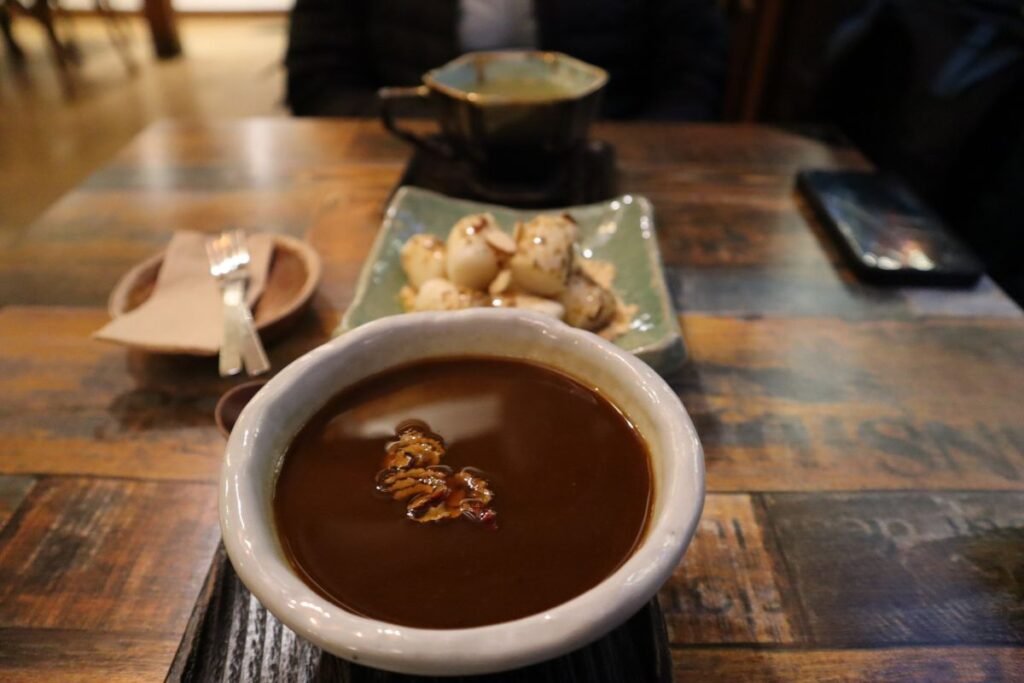
Myeong-dong Shopping Street
As the final stop on Day 1 of your Korean itinerary, Myeong-dong is a must-visit district. It’s a bustling area that combines shopping, fashion, and some of the best street food in Korea. This vibrant neighborhood is lined with luxury department stores, international labels, and local brands. You’ll find everything from trendy clothing to cosmetics, shoes, and accessories—perfect for satisfying any shopping craving.
But for me, the true highlight of Myeong-dong was the street food scene. The streets are filled with vendors serving up irresistible Korean snacks, including tteokbokki (spicy rice cakes), hotteok (sweet pancakes), grilled skewers, and even unique twists like lobster tails and rainbow cheese toast. It’s an absolute treat for your taste buds!
Myeong-dong is also home to some of Seoul’s best Korean BBQ joints. We dined at Muhangamdong-Korean BBQ, and opted for an “all-you-can-eat” option, we paid around $20 USD per person. The food was so good that we had to return before leaving South Korea!
The energy in Myeong-dong is electric. Locals and tourists alike soak up the area’s lively, vibrant atmosphere. Whether you’re indulging in street food, shopping for unique finds, or just enjoying the buzz, there’s always something happening. Myeong-dong is a sensory overload that deserves a spot on any Korea itinerary.
Admission: free of charge.
Opening hours: vary according to stores.

Day 2 - Hwacheon Sancheoneo Ice Festival
The Hwacheon Sancheoneo Ice Festival is a winter wonderland that takes place every January in Hwacheon, Gangwon Province, just 1.5 hours by car from Seoul. Recognised by CNN as one of the “seven wonders of winter”, it’s a unique celebration where everything is blanketed in ice and snow. The highlight? Catching sancheoneo (cherry salmon) through holes drilled into the frozen lake. This rare cold-water fish thrives only in pristine mountain streams, and you can grill and savour your catch at on-site barbecue stations.
Beyond fishing, the festival offers plenty of fun activities, including sledding, bobsledding, ice soccer, and exploring the world’s largest indoor Ice Sculpture Plaza. The plaza showcases intricate snow and ice artworks, including iconic landmarks, and is a must-see addition to your visit.
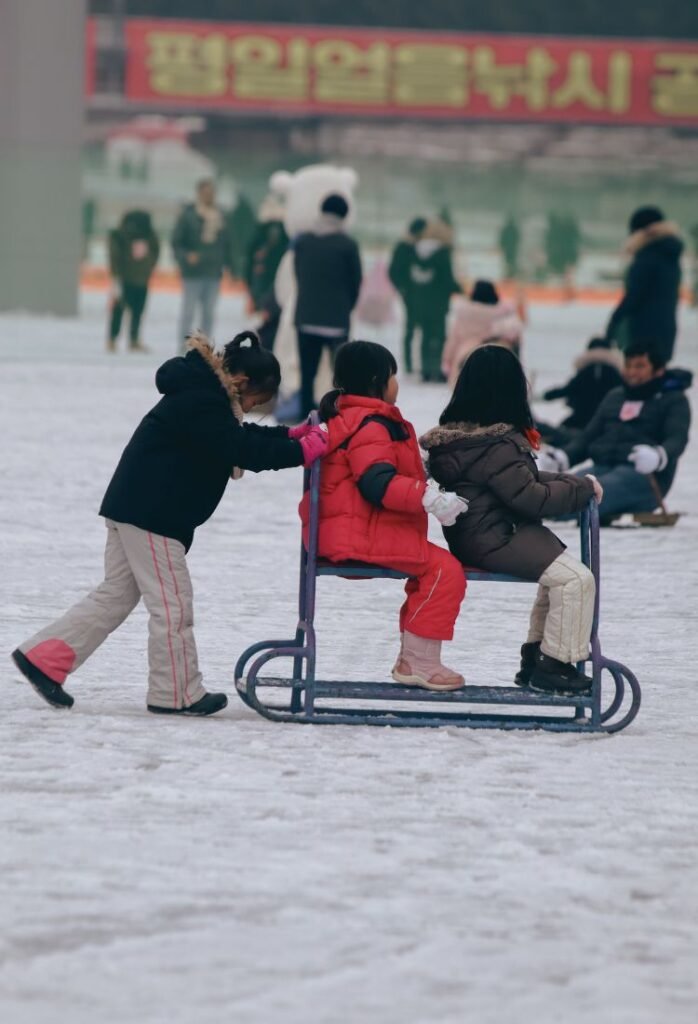

Ice sledding and ice fishing—two of the many thrilling activities at the Hwacheon Winter Festival.
To simplify the experience, I recommend joining a guided tour. We booked this tour through GetYourGuide, which included round-trip transport, an English-speaking guide, admission fees, fishing gear, access to activities, and even grilled fish. It was incredible value and hassle-free, with pick-up conveniently from Myeongdong Station at 9:00 AM.
Upon arrival, we were welcomed with delicious grilled sancheoneo—perfectly seasoned and wrapped in foil over a charcoal barbecue. Later, I tried my luck at ice fishing and managed to catch one fish, which I gave to staff to grill for others. Whether you catch fish or not, the tour ensures everyone enjoys a fresh meal.
Sliding around on the ice sled felt like being a kid again—pure joy and laughter. The Ice Sculpture Plaza, visited in the evening, was a magical finale, with massive, intricately carved ice structures glowing under vibrant lights.
This festival is a quintessential winter experience and an unmissable part of any Korea itinerary for winter. Make sure to dress warmly, and prepare for a day filled with adventure, delicious food, and unforgettable memories!
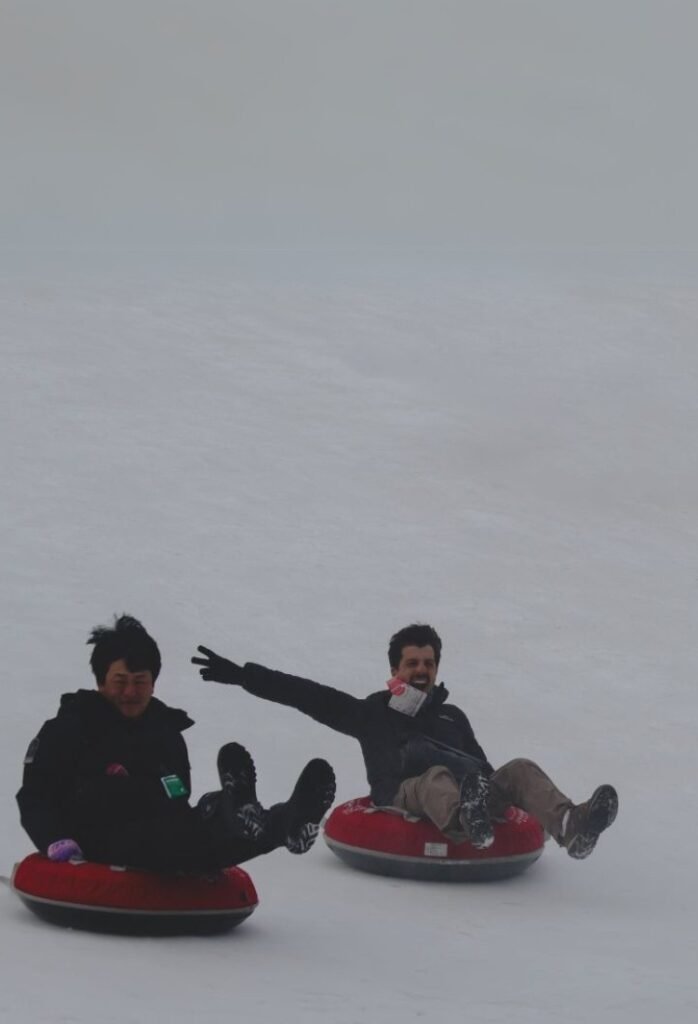
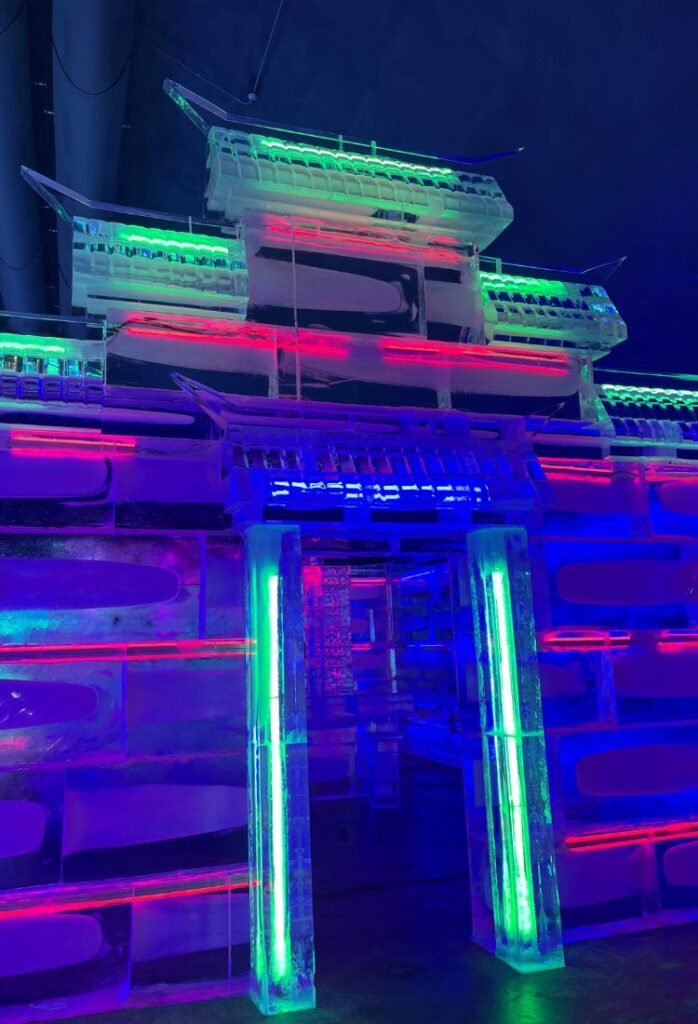
Left: ice sledding, one of the main activities at the festival. Right: ice artwork at the Ice Sculpture Plaza.
Day 3 - DMZ + Seoul
No trip to South Korea is complete without visiting the DMZ (Demilitarized Zone), the historic buffer zone separating North and South Korea. This powerful site not only offers a rare glimpse into the tense history between the two nations but also serves as a stark reminder of the ongoing quest for peace and reunification. Here’s why you should add the DMZ tour to your South Korea itinerary!
The DMZ is more than just a border—it’s a significant symbol of conflict and division. While the zone itself is demilitarized, the borders on both sides are heavily fortified, making it one of the most militarized areas in the world.
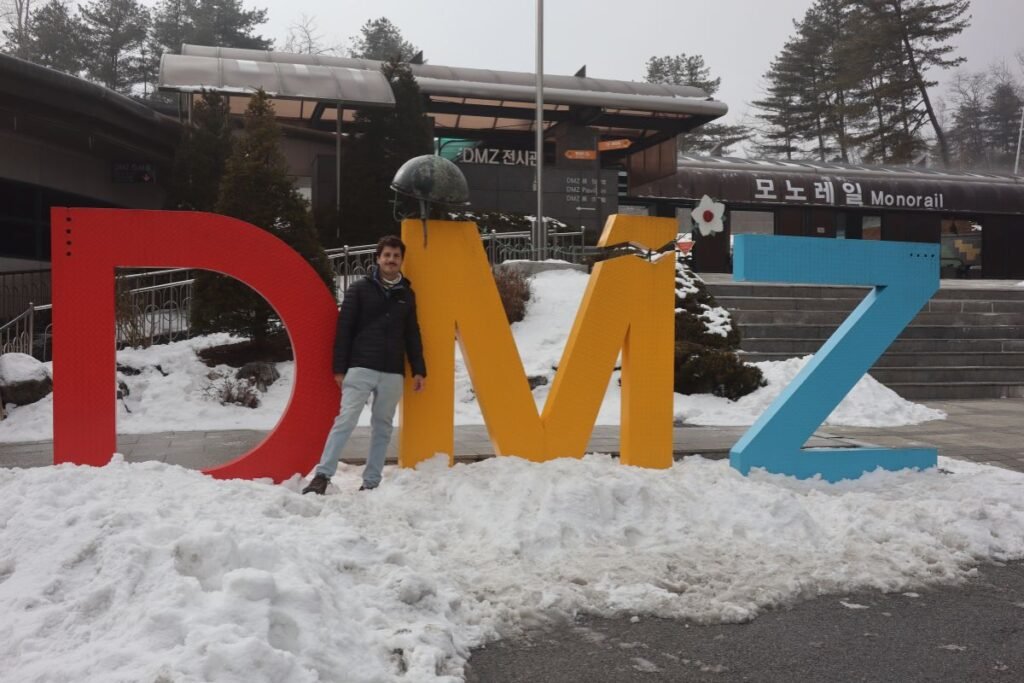
For those wanting a deeper understanding of the DMZ, check out my dedicated post on everything you need to know about the DMZ here.
How to Get to the DMZ: Tour vs. DIY
While it’s possible to reach Imjingak, located 7 km from the DMZ, by public transport from Seoul, entry into the military-controlled areas requires special permits, which are only available through guided tours.
For convenience and peace of mind, I highly recommend booking a DMZ tour from Seoul. This way, you won’t have to worry about logistics or permits, and your guide will provide fascinating insights into the Korean War and ongoing conflicts that you won’t find on the standard information boards.
We booked this tour and we had a great experience, but you can also explore other options on GetYourGuide, —just make sure to check the reviews and inclusions.
We did our tour during the chilly Korean winter in January. Our knowledgeable guide, Joey, made the experience even more enriching with historical context and fascinating facts. The tour included transport from and to Seoul, with pick-up at Myeongdong Station at 7:00 and a return around 16:30.
DMZ Tour Highlights
Freedom Bridge
This historic wooden bridge was once used by prisoners of war returning from North Korea after the Korean War armistice in 1953, marking their path to freedom. It’s now a poignant symbol of hope and reconciliation within the DMZ. The bridge is now blocked off and its surrounding area is adorned with colourful ribbons and messages of peace left by South Koreans and international visitors alike.
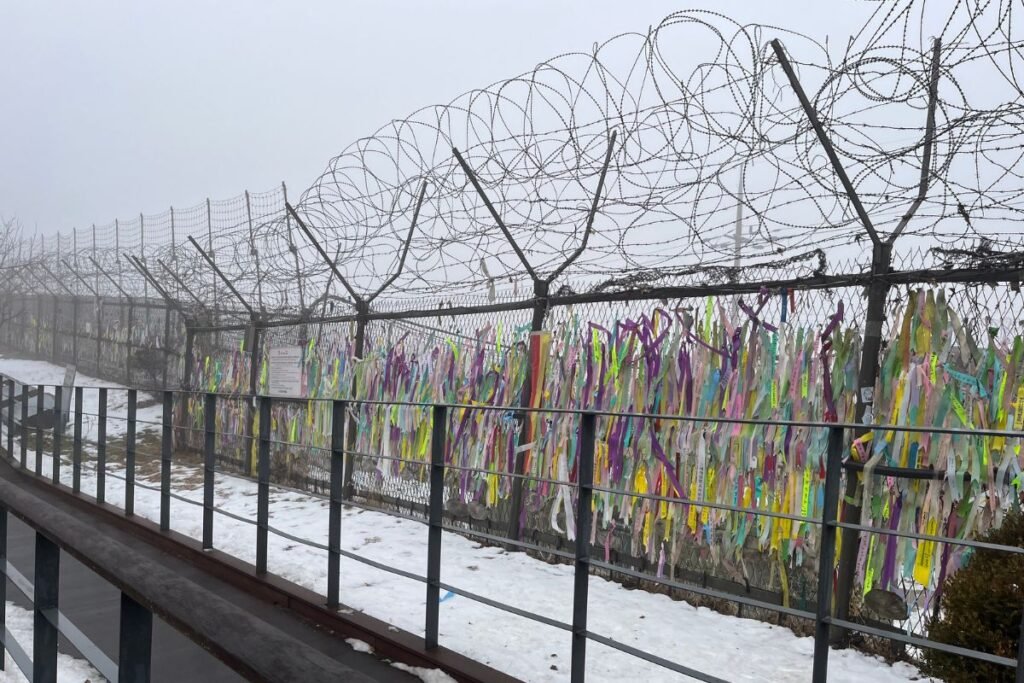
Dorasan Station
Dorasan Station is South Korea’s closest railway station to North Korea. Originally part of a line linking Seoul to China and Europe, it was destroyed during the Korean War but was rebuilt in 2002 as a symbol of future reunification. While it’s no longer used for international travel, visitors can walk through the station, see signs pointing to North Korea, and even buy a symbolic ticket to Pyeongyang.
Dora Observatory
A key highlight of the DMZ tour, Dora Observatory sits atop Mount Dora and provides an unrivalled view into North Korea through powerful binoculars. On clear days, you can spot North Korea’s ‘Propaganda Village’ (Kijong-dong), the industrial city of Kaesong, and the iconic flagpoles that mark the border.


Flagpoles of North & South Korea on both sides of the border!
Third Infiltration Tunnel
The Third Infiltration Tunnel, also known as the “Aggression Tunnel,” is the most renowned of the four tunnels discovered beneath the border between North and South Korea, all of which were excavated by North Korea. Its close proximity to Seoul led experts to believe it was designed for a surprise attack on the capital, with the capacity to mobilise up to 30,000 soldiers per hour.
Discovered in 1978, this secret passage stretches over 1.6 km, with 453 metres extending into South Korean territory. Visitors descend a steep incline into the tunnel. Inside, the Military Demarcation Line, the actual geographical division between the two countries is blocked by three concrete barricades; you can venture as far as the third barricade, placing you less than two blocks from North Korea. Note that photography is strictly prohibited and you have to leave your phone and camera in a locker.
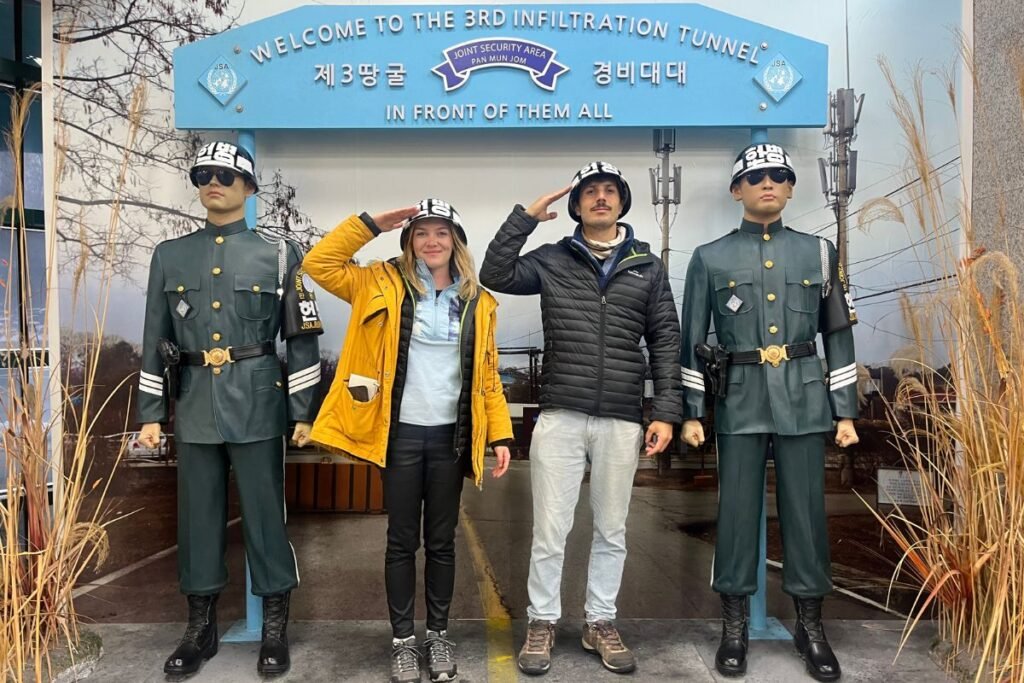
Joint Security Area (JSA)
The Joint Security Area (JSA), or Panmunjeom, is the iconic blue building at the heart of the DMZ where North and South Korean soldiers stand face-to-face. The facility straddles the border—half in South Korea and half in North Korea—and was used for diplomatic engagements. It was the historic site where the Korean War Armistice Agreement was signed and remains the closest point to North Korea for visitors. However, following an incident in July 2023 when an American soldier defected to North Korea, the JSA is no longer accessible to tourists, with no reopening date in sight.
Suspension Bridge
The red suspension bridge “Gloucester” is a celebrated landmark on DMZ tours. Spanning over 220 metres in length and standing 10 metres high, it is currently the longest suspension bridge in South Korea. Its name pays tribute to the 1st Battalion Gloucester Regiment of the British Army, renowned for their service during the Korean War. Before booking your tour, make sure to check if this attraction is included, as it is typically not part of half-day tours and may be offered as an optional, separately charged experience.
Tips for tour DMZ tour:
- Bring your passport: You’ll need it for inspection at the DMZ checkpoint.
- No drones: Photography is strictly prohibited in this highly sensitive area.
Back In Seoul
You are going to be returning to Seoul either in the afternoon or the evening, depending on whether you booked a half-day or full-day DMZ tour. It’s highly likely that one of the drop-off stops of the bus will be Myeongdong station. Given that and depending on the location of your hotel and how tired you are, you may want to visit the N-Tower or go back to Myeong-dong Shopping Street (please see previous section on Myeong-dong).
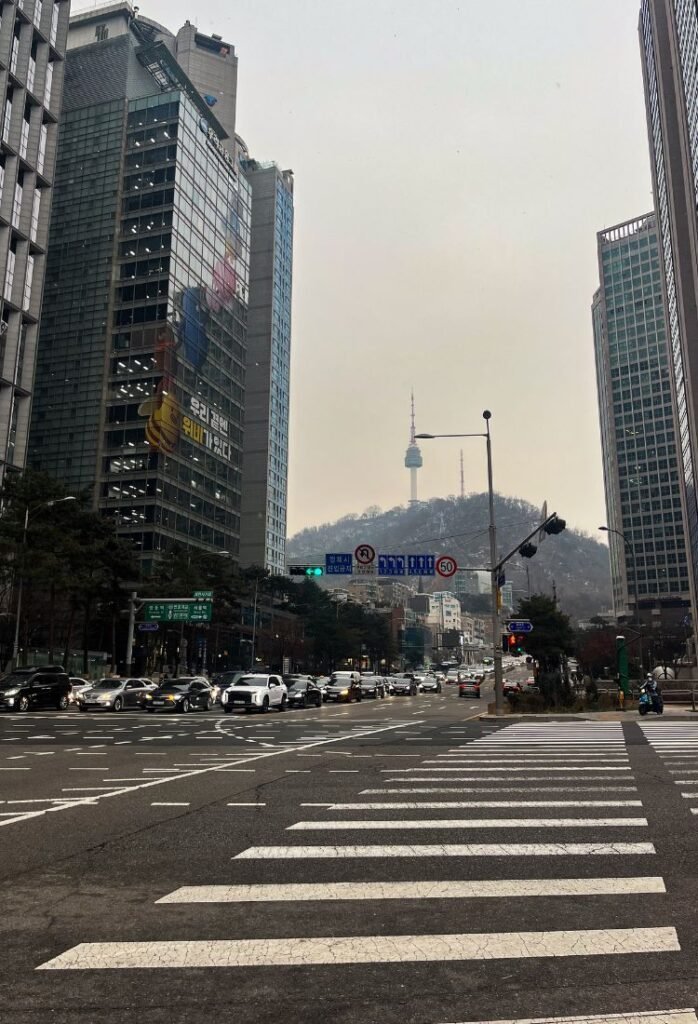
Namsan Seoul Tower (N-Tower)
Namsan Seoul Tower, or N-Tower, is one of Seoul’s most iconic landmarks, visible from many spots across the city. Perched atop Namsan Mountain, it offers stunning panoramic views of the city—a perfect way to unwind and reflect after the intensity of your DMZ visit. But the tower isn’t just about the views; you can also explore its revolving restaurant, cozy cafes, and even leave a love lock on the famous “Locks of Love” fence.
Opening Hours:
- Monday to Friday & Sunday: 10.00 – 23.00
- Saturday: 10.00 – midnight
The best time to visit N-Tower is in the evening, especially if you want to catch the sunset and enjoy a magical, unforgettable experience.
If you’re interested in accessing the Observatory (optional), you’ll need to purchase a ticket, either at the N-Tower or online. The cost is 21,000 won (around $14 USD).
Pro Tip: If you’re planning to buy a lock for the “Locks of Love” fence, it’s way cheaper to buy it from a convenience store in the city rather than at the N-Tower itself.
How To Get To Namsan Tower
After returning to Seoul, N-Tower is easily accessible from Myeong-dong.
By cable car
Taking the cable car to N-Tower offers a scenic and enjoyable ride up Namsan Mountain, providing stunning aerial views of Seoul along the way. To reach the boarding place, walk for about 10-15 minutes following the street of the right side of the Pacific Hotel, after coming out of the exit 3 of Myeong-dong Station. Follow Zaemiro Street, which is a 450-metre road decorated with cartoon characters that leads out of the exit 3 of Myeong-dong station. Operating hours of the cable are 10:00 to 23:00, every day. More info here.
By shuttle bus
You can get to N-Tower by riding the Namsan Sunhwan Shuttle Bus (number 01A, 01B) which provides a scenic route up the mountain. They run daily until 23:00 and are cashless, T-money accepted. The bus stop is around 4 minutes’ walk from Myeong-dong subway station exit 1.
Final Thoughts
Winter in Korea is truly something special, offering a perfect mix of culture, history, and winter charm that’s hard to beat. Whether you’re a history enthusiast, a nature lover, or a foodie, there’s no shortage of experiences to make your trip unforgettable during this magical season. I hope this Korea itinerary sparks ideas for your own winter adventure. Don’t forget to check out my other posts about this captivating country below for even more travel tips and inspiration!




Leave a Reply